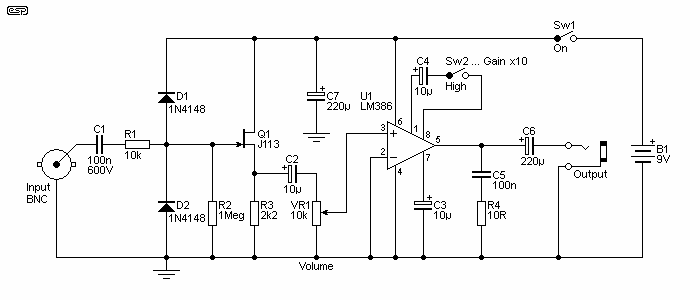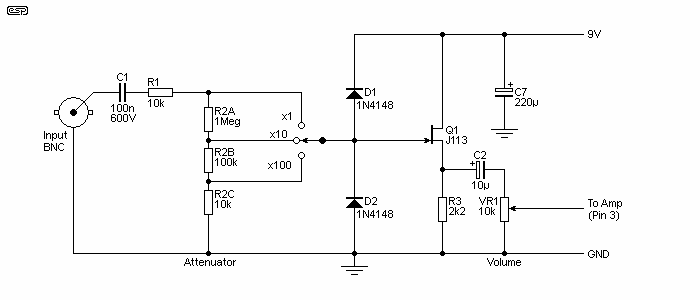

|
| Elliott Sound Products | Project 164 |
Signal tracing is a way to diagnose where a fault lies in an audio system. It's nowhere near as good as an oscilloscope, but it's a cheap alternative that can be useful in many cases. The idea is that you apply a signal to the input of whatever isn't working, and trace the signal through the circuit until the audio disappears. It's not useful in a direct coupled power amplifier stage though, because a fault in one part of the circuit causes the entire amplifier to stop working.
Although it has limitations, if you have a preamp, crossover network or other multi-stage circuit, you can follow the path of the signal through each individual section until you find the point where the signal stops, becomes distorted, or just sounds wrong. This is much easier in a stereo circuit, because you can compare the level and sound from each channel at the same point in the circuit.
Like an oscilloscope, the signal tracer doesn't usually give you enough information for you to know exactly what's wrong, but it does mean that you can eliminate everything from the input to the point where the signal changes. The stage that provides a signal that doesn't match what you expect (or hear from the other channel) is the one at fault. This means that your search is narrowed down to a specific part of the circuit.
Once you get to that point, it's usually easy enough to determine what's wrong with the help of a multimeter, and you check for abnormal DC voltages or other circuit anomalies that are symptoms of the fault. It's important to understand that when fault finding, any anomalous voltage is a symptom of the fault, and is not the fault itself. Fault finding is a skill, and it's not something that everyone will be able to master to the level of a skilled service person. However, by following a disciplined process and learning what is significant and what is not, you can usually work out what's wrong with many pieces of equipment.
It's very important to understand the circuit itself before you start. You don't need to know how it was designed, but you do need to be able to follow a circuit diagram and estimate what you should (or should not) be able to measure or hear at various points in the circuit.
For more detailed information of general service techniques, see the articles Troubleshooting - Part 1 and Troubleshooting - Part 2. Read them in order, because the first article covers all the basics that are essential background for anyone starting out in fault finding.
You will need an audio oscillator. While it's possible to use music (from a radio tuner or CD), an oscillator is far more useful overall. Project 86 is a good place to start. It's easy to build, has a wide frequency range, and works very well. It doesn't need any exotic parts, and although its distortion is comparatively high, it's perfect for fault finding.
The technique of signal tracing is perfect for opamps circuits, especially where there are several stages. The ideal signal tracer is an oscilloscope, but may hobbyists can't justify the expense. The cost may not be a great as imagined though - perfectly good (but older) units are usually available on auction websites, and electronics suppliers often have basic oscilloscopes for very reasonable prices. The oscilloscope is such a useful tool that you'll quickly wonder how you ever survived without one.
Assuming that an oscilloscope is not available, you need a small power amplifier with a suitable speaker - something around a couple of Watts at the most. I don't recommend headphones, as you may probe a point with a high signal level and risk hearing damage.
The tracer amplifier needs lots of gain, and a gain (or volume) control is essential. It also needs to have high input impedance so it doesn't load the circuit under test. Nothing fancy is needed though - a high impedance buffered input followed by small power amp IC is ideal.

Figure 1 - Signal Tracer Schematic
A suitable circuit is shown above. It's easy to build and inexpensive. The JFET input buffer provides high input impedance, and the LM386 amplifier IC can be used to drive a small speaker or headphones (the latter with caveats - see below). If you can't get the suggested JFET, most others will work, but you may need to change the value of R3 (2k2) to obtain a sensible voltage on the source pin. Around 4V is ideal, but anything greater than 1.5V will usually be alright. The volume pot (VR1) can be log or linear, but for this application a linear pot is probably better.
The circuit will drive an 8 ohm speaker quite effectively. Don't imagine that the circuit as shown is any use for low power hi-fi though - the LM386 is not a high performance amp. Feel free to use a 'real' power amp (either discrete or integrated) if it makes you feel any better, but you only need a couple of Watts at the very most. You can also use headphones, but be aware that a high level signal will create a very high SPL in the 'phones that can easily damage your hearing.
The maximum gain is fairly high. The first stage has no gain, but the LM386 can be switched between a gain of 20 and 200. The circuit will be noisy, will pick up hum, and is generally fairly awful, but is perfect for the simple task of signal tracing. At maximum gain, frequency response is fairly limited as well, but it doesn't matter. All it is for is to allow you to trace the signal through the circuit, and you can listen to whatever you can pick up at each point along the way.
C1 can use a lower voltage cap if the tracer will never be used with valve (tube) amplifiers. The purpose of R1, D1 & D2 is to ensure that transient signals cannot damage the opamp input if the tracer is connected to a high voltage point. Even if you never work with valves, I recommend that these diodes be included. At some stage, you may wish to listen to the power supply ripple of a power amp (for example). It you intend to probe around valve amps, I suggest that you use an oscilloscope x10 attenuator probe at the input.
Note that as shown, the maximum input (signal) voltage is limited to around 1V RMS, so in most cases you will need to adjust the input level to prevent the JFET from distorting high level signals. If you use a switchable oscilloscope probe (x1 and x10), the maximum input will be 10V RMS when the probe is switched to x10 attenuation. In the interests of simplicity, an input attenuator has not been included in the circuit shown, but you can add one if you wish. I've shown (and strongly recommend) the use of a BNC connector for the input. This means that budget oscilloscope probes can be used, which are better and safer than most other probe systems.

Figure 2 - Optional Input Attenuator
The attenuator is not exact, but it's more than acceptable for the purpose. Signal tracing is not a precision technique so using a precision attenuator would be a bit silly. As shown, it has attenuation ranges of (approximately) x1, x10 and x100, although the highest range isn't necessary unless you work on valve amplifiers. If you do use the signal tracer on a valve amp, don't be tempted to listen to the signal on the plate(s) of the output valve(s). Firstly, if there's a signal there you'll hear it through the speaker output, and secondly, the peak-to-peak voltage can be high enough to cause the input cap to fail.
A push-pull valve output stage with a 500V supply can generate close to a 1kV peak-to-peak voltage on the plates, and that will stress the input cap and R2A (1 Meg), and is very dangerous. It's essential that you understand the circuit you're working on and the voltages you are likely to encounter. It is your responsibility absolutely to ensure that the unit is used in a safe manner and is not subjected to voltages that may cause component failure, injury or even death.
The signal tracer can be built on Veroboard or similar, and since it uses a 9V battery there's no need for a power supply. Most of the circuitry is non-critical, but if you include the attenuator and expect to work with high voltages, wire the resistors (R2A, B & C) as well as C1 and R1 off the board. Veroboard does not have sufficient insulation to ensure that there can be no breakdown when a high voltage is applied.
The unit can be built into a suitable case, which can include a small monitor speaker. However, I suggest that you include an output socket so that an external speaker can also be used. This also allows the use of headphones, provided you are extremely careful to keep the level low enough to protect your hearing. If you do intend to use headphones, consider wiring the socket with a series resistor. Between 100 and 220 ohms for each channel should be alright (although even more will give added protection), and this will limit the maximum power to something that will be very loud, but hopefully not so loud that you damage your hearing.
Remember that most headphones can produce up to 100dB SPL with only 1 milliwatt, and a 9V supply with 32 ohm 'phones can deliver over 300mW to each earpiece - that's (theoretically an SPL of almost 150dB!).
In use, NEVER use the tracer without the earth/ ground lead connected. This is important no matter what kind of probe you use.
As noted in the introduction and the troubleshooting pages, you need to ensure that the signal source can be adjusted to cover the required frequency range. Most testing will be done at a frequency between 200Hz and 1kHz (the latter is extremely annoying). There is rarely a need to test at very low or high frequencies. You can, but it usually doesn't tell you anything interesting.
The will be times when you will listen to power supplies to verify that they are hum free. All supplies using a full wave rectifier will generate 100Hz (120Hz with 60Hz mains) hum or buzz, and this should never be audible on the output of a regulator IC. This provides a quick and easy way to verify that regulators have enough voltage across them to ensure that all ripple (hum and buzz) is removed.
This is not a complex project, but will be invaluable for anyone who does not have an oscilloscope. Although I use my oscilloscope almost exclusively, sometimes the only way to fully understand what's happening is to listen to it. This is especially true if you are inexperienced with test equipment in general and oscilloscopes in particular. Many of us have been doing electronic repairs for so long that we can not only visualise an audible signal, but can look at an oscilloscope trace and know what the waveform will sound like.
This is only possible with experience, so even if you do have an oscilloscope, you will find this little project surprisingly useful.
 Main Index
Main Index
 Projects Index
Projects Index